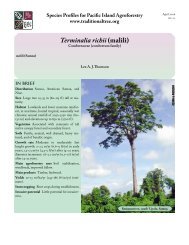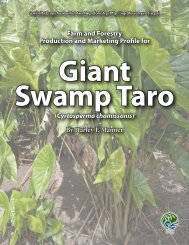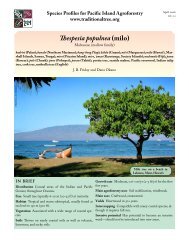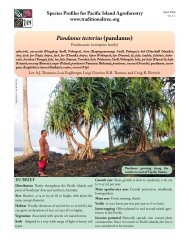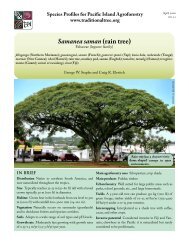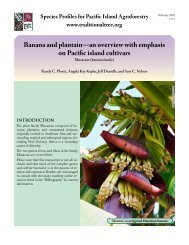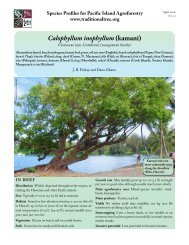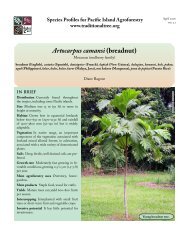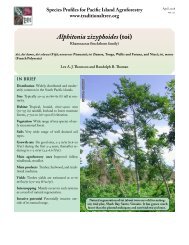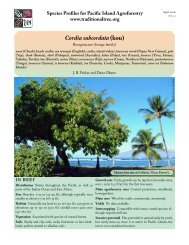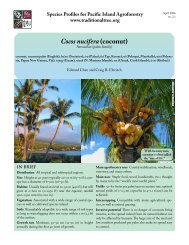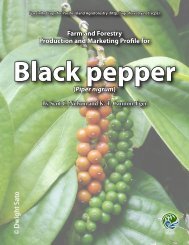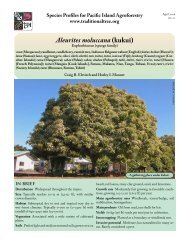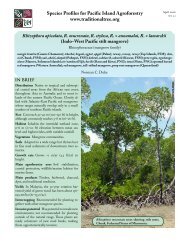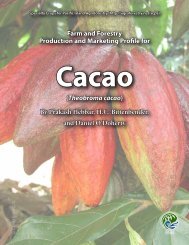Farm and Forestry Production and Marketing Profile for Mangosteen ...
Farm and Forestry Production and Marketing Profile for Mangosteen ...
Farm and Forestry Production and Marketing Profile for Mangosteen ...
Create successful ePaper yourself
Turn your PDF publications into a flip-book with our unique Google optimized e-Paper software.
Specialty Crops <strong>for</strong> Pacific Isl<strong>and</strong> Agro<strong>for</strong>estry (http://agro<strong>for</strong>estry.net/scps)<br />
<strong>Farm</strong> <strong>and</strong> <strong>Forestry</strong><br />
<strong>Production</strong> <strong>and</strong> <strong>Marketing</strong> profile <strong>for</strong><br />
<strong>Mangosteen</strong><br />
(Garcinia mangostana)<br />
By Yan Diczbalis
USES AND PRODUCTS<br />
<strong>Mangosteen</strong> is primarily consumed as a fresh fruit. The fruit<br />
is common delicacy <strong>and</strong> often referred to as the “Queen of<br />
Fruit” in Southeast Asia.<br />
The volume of production in Thail<strong>and</strong> is increasing <strong>and</strong> fruit<br />
is now being processed into value-added products such as<br />
jam, c<strong>and</strong>y, <strong>and</strong> wine.<br />
In traditional communities, the fruit pericarp (rind) was<br />
used as an antibacterial agent <strong>and</strong> <strong>for</strong> curing diarrhea. The<br />
use of the fruit rind <strong>and</strong> or whole fruit as a medicinal/nutriceutical<br />
beverage has been a recent trend in western societies.<br />
<strong>Mangosteen</strong> extracts <strong>and</strong> processed products have now<br />
entered the worldwide health food <strong>and</strong> nutritional supplement<br />
market.<br />
The timber, dark red in colour, is used when available in<br />
cabinet making <strong>and</strong> where a heavy durable wood is required.<br />
Scale of commercial production worldwide <strong>and</strong> in<br />
the Pacific<br />
Thail<strong>and</strong> is the world’s largest producer of mangosteen,<br />
producing approximately 240,000 metric tons (MT) annually,<br />
with exports recorded at 15,000 MT in 2006. Malaysia,<br />
Vietnam, <strong>and</strong> Indonesia are also major producers. Most<br />
people enjoy mangosteen <strong>and</strong> the fruit has a ready market in<br />
western countries where it is considered a tropical delicacy.<br />
Recent production in Central America is being exported<br />
into Europe. A modest commercial production occurs in<br />
Hawai‘i, primarily <strong>for</strong> local markets. The fruit has a good<br />
postharvest life which is beneficial <strong>for</strong> export, although it is<br />
regarded due to lack of contradictory evidence as a potential<br />
fruit fly host.<br />
NOMENCLATURE<br />
Preferred scientific name<br />
Garcinia mangostana L<br />
Family<br />
Clusiaceae<br />
Non-preferred scientific names<br />
<strong>Farm</strong> <strong>and</strong> <strong>Forestry</strong> <strong>Production</strong> <strong>and</strong> <strong>Marketing</strong> <strong>Profile</strong> <strong>for</strong> <strong>Mangosteen</strong> by Yan Diczbalis 2<br />
None.<br />
Common names<br />
English: mangosteen, purple mangosteen, queen of fruit<br />
Indonesia, Philippines: manggis<br />
Thail<strong>and</strong>: mang khút<br />
Vietnamese: cây măng cụt<br />
Japanese: mangosuchin<br />
French: mangostan, mangostanier, mangoustan,<br />
mangoustanier<br />
BRIEF BOTANICAL DESCRIPTION<br />
<strong>Mangosteen</strong> is a slow growing, pyramidal shaped evergreen<br />
tree growing up to 30 m (100 ft). The single stemmed trunk<br />
has symmetrical <strong>and</strong> alternatively opposite branches. The<br />
trees flush from terminal shoots 3–4 times per year. Young<br />
emerging leaves are red/pink in colour, turning light green<br />
<strong>and</strong> dark green as they mature. The flower buds protrude<br />
from between the terminal leaf petioles as small bulbous<br />
protrusions usually as single floral bud but also occur as<br />
double or triple buds. The flowers, having four sepals <strong>and</strong><br />
four petals, are borne on short thick stalk. <strong>Mangosteen</strong> produces<br />
only female flowers. The tree has large thick, elliptic<br />
shaped leathery leaves.<br />
Left: Perfect fruit on display. Right: 100% mangosteen fruit drink sold as “super fruit” nutritional supplement in a health food store.<br />
Kahalui, Hawai‘i.
Left: Symmetrical <strong>and</strong> alternatively opposite branching in mangosteen. Note that internal secondary branches have been removed to<br />
facilitate air movement through the tree. Top right: <strong>Mangosteen</strong> shoot enclosed by the terminal leaf pair petioles (leaf stalks). Bottom<br />
right: New leaf flush.<br />
DISTRIBUTION<br />
Native range<br />
<strong>Mangosteen</strong> is believed to be a sterile hybrid between G.<br />
hombroniana <strong>and</strong> G. malaccensis (Yaacob <strong>and</strong> Tindall 1995).<br />
It was originally distributed in the Malay Peninsula <strong>and</strong> the<br />
eastern Indonesian archipelago <strong>and</strong> the isl<strong>and</strong> of Borneo.<br />
Current distribution worldwide<br />
The tree is widely distributed throughout Southeast Asia<br />
where it is an important commercial fruit crop. The crop is<br />
grown extensively in Thail<strong>and</strong>, Cambodia, Vietnam, Philippines,<br />
Laos, <strong>and</strong> Burma. <strong>Mangosteen</strong> is also widely distributed<br />
into northern Australia, India, West Indies, Central<br />
<strong>and</strong> South America, Africa, <strong>and</strong> Hawai‘i. There are also<br />
claims of flowering <strong>and</strong> fruit specimens grown in greenhouses<br />
in Engl<strong>and</strong>. Viable commercial production generally<br />
occurs within 10° of the equator but extends to 18°S on the<br />
east coast of Australia <strong>and</strong> 22°N in Hawai‘i. Specimen plants<br />
exist throughout the Pacific, however, it is not widely commercialized<br />
in this region.<br />
Relatives of mangosteen such as G. hombriana, G. warrenii,<br />
G. livingstonei are widely distributed (Borneo, Australia, <strong>and</strong><br />
Africa). Many of the <strong>for</strong>mer Rheedia species in South America<br />
have been taxonomically reclassified as Garcinia species<br />
(e.g., G. intermedia, G. madrona, G. brazilliensis, <strong>and</strong> G. laterafolia).<br />
The Pacific is the home of a few important edible relatives,<br />
namely, Garcinia pseudoguttifera, G. hollrungii, G. jaweri,<br />
<strong>and</strong> G. floribunda (Walter <strong>and</strong> Sam 2002). Garcinia dulcis<br />
is commonly found in the Pacific following introduction<br />
as a fruit suited to village production. There are also native<br />
ornamental/<strong>for</strong>est species such as heilala (Garcinia cessilis),<br />
<strong>and</strong> feto‘omaka (Garcinia myrtifolia) in Tonga (Chay et al.<br />
2007).<br />
ENVIRONMENTAL PREFERENCES AND<br />
TOLERANCES<br />
<strong>Mangosteen</strong> prefers a warm <strong>and</strong> humid environment with<br />
well distributed rainfall <strong>and</strong> a 3–5 week dry season. The<br />
plant is native to the equatorial tropics. Young seedlings<br />
Specialty Crops <strong>for</strong> Pacific Isl<strong>and</strong> Agro<strong>for</strong>estry (http://agro<strong>for</strong>estry.net/scps) 3
prefer a high level of shade <strong>and</strong> young trees prefer moderate<br />
shade. Mature trees provided with adequate moisture <strong>and</strong><br />
nutrients will grow, flower, <strong>and</strong> fruit in full sun if humidity<br />
remains high. Weibel et al. (1993) report that maximum<br />
photosynthesis in mangosteen occurs at low light levels<br />
similar to that observed in understory rain<strong>for</strong>est trees. In<br />
severe environments with high irradiance, e.g., the monsoonal<br />
tropics of Northern Territory, Australia, mangosteen<br />
struggles in full sunlight during the dry season even with<br />
adequate irrigation.<br />
Soils<br />
<strong>Mangosteen</strong> prefers deep, well drained soils with good<br />
moisture retention. The tree grows well on deep river loams.<br />
Soils should be high in organic matter. It has been observed<br />
to per<strong>for</strong>m poorly on s<strong>and</strong>y soils low in organic matter. In<br />
North Queensl<strong>and</strong>, trees have been grown on soils with a<br />
pH range of 4.8–7.6 <strong>and</strong> 1.5–7.9% organic matter.<br />
GROWTH AND DEVELOPMENT<br />
The mangosteen is a slow growing tree taking 2–3 years <strong>for</strong><br />
seedlings to reach a stage where they can be planted in the<br />
field. Under ideal conditions of temperature, soil moisture<br />
<strong>and</strong> light, young mangosteens may produce 4–5 vegetative<br />
flushes per year, however, only 2–3 flushes is common. The<br />
leaf petioles of the terminal flush hide the growing tip. Vegetative<br />
<strong>and</strong> reproductive buds emerge through the joint between<br />
the two terminal leaf stalks.<br />
Young seedlings <strong>and</strong> nursery trees require at least 50% shade.<br />
Newly planted trees also prefer shade provided artificially<br />
Elevation, rainfall, <strong>and</strong> temperature<br />
Elevation range<br />
Mean annual rainfall<br />
Rainfall pattern<br />
Dry season duration (consecutive<br />
months with 30 cm [12 in]) to allow taproot development to occur.<br />
Wood from a bearing tree can also be grafted onto seedling<br />
rootstock. Such grafted trees tend to flower earlier, but fruit<br />
are smaller <strong>and</strong> tree vigor <strong>and</strong> shape is difficult to maintain.<br />
<strong>Farm</strong> <strong>and</strong> <strong>Forestry</strong> <strong>Production</strong> <strong>and</strong> <strong>Marketing</strong> <strong>Profile</strong> <strong>for</strong> <strong>Mangosteen</strong> by Yan Diczbalis 4
Left: Week-old mangosteen seedlings. Right: A small grafted tree that is already bearing fruit. Rayong, Thail<strong>and</strong>.<br />
Hence there are few if any advantages to grafting <strong>and</strong> it is<br />
not commonly undertaken commercially.<br />
<strong>Mangosteen</strong> seedlings are notoriously slow growing. A porous<br />
but moist mix is important <strong>for</strong> good growth. In Australia,<br />
a mix of equal parts of s<strong>and</strong>, peat, <strong>and</strong> composted pinebark<br />
is recommended. Regular use of foliar fertilizers <strong>and</strong><br />
small amounts of urea or sulphate of ammonia can assist<br />
rapid development. Shade, water <strong>and</strong> nutrient management,<br />
<strong>and</strong> warm conditions are critical to rapid seedling development.<br />
Well developed nursery trees approximately 100 cm [40 in]<br />
tall are preferred <strong>for</strong> planting out. <strong>Mangosteen</strong> needs particular<br />
care at planting. The roots are sensitive to disturbance<br />
<strong>and</strong> moving plants from the shade house environment to<br />
the open field requires a hardening off process or the provision<br />
of shade in the field.<br />
Companion plants such as banana or other fast growing<br />
food crops can provide useful shade <strong>and</strong> protection <strong>for</strong><br />
young field-planted mangosteen trees.<br />
CULTIVATION<br />
Variability of species <strong>and</strong> known varieties<br />
Until recently, all mangosteen trees were considered to be<br />
identical because fruit <strong>and</strong> seed develop without sexual fertilization<br />
taking place. Studies in Malaysia (Bin Osman <strong>and</strong><br />
Rahman Milan 2006) indicated that 16 of 830 mangosteen<br />
accessions collected were identified as being distinctly different.<br />
Growers in non-traditional mango steen growing areas<br />
have noted that fruit <strong>and</strong> tree shape may vary depending on<br />
the seed source. Genetic finger printing studies (S<strong>and</strong>o et al.<br />
2005) carried out in Australia showed that there were three<br />
distinct varieties growing in Australia. Only two of the varieties<br />
have fruited <strong>and</strong> the major difference in “Borneo”sourced<br />
seed material is that the fruit are ellipti cal in shape<br />
<strong>and</strong> the trees have noticeably sparser foliage with upright<br />
branches. The more usual spherical fruit variety is preferred<br />
as it is considered more vigorous <strong>and</strong> the fruit are easier to<br />
pack.<br />
Basic crop management<br />
There are no special horticulture techniques required to produce<br />
mangosteen except the skill <strong>and</strong> experience required to<br />
raise healthy trees. Well managed, healthy mangosteen trees,<br />
clearly evident by appearance, will flower <strong>and</strong> fruit earlier<br />
<strong>and</strong> produce more abundant <strong>and</strong> larger fruit. Patience <strong>and</strong><br />
Entries in a “largest fruit” competition in Chanthaburi, Thail<strong>and</strong>.<br />
The largest fruit weighed 230 gm (8 oz), far larger than<br />
the average size <strong>for</strong> mangosteen fruit of 70–125 gm (2.5–4.5 oz).<br />
Specialty Crops <strong>for</strong> Pacific Isl<strong>and</strong> Agro<strong>for</strong>estry (http://agro<strong>for</strong>estry.net/scps) 5
Top: A young mangosteen seedling planted with pigeon pea<br />
(Cajanus cajan), a leguminous tree <strong>for</strong> temporary shade. San<br />
Marcos district, Guatemala. Middle: Juvenile mangosteen<br />
trees with companion banana <strong>and</strong> artificial shade in North<br />
Queensl<strong>and</strong>. Bottom: Young mangosteen seedling growing in<br />
the shade of an old rambutan tree it will eventually replace.<br />
Chanthaburi, Thail<strong>and</strong>.<br />
Young mangosteen trees that were originally established in commercial<br />
bananas <strong>and</strong> grown with palms as permanent shade. Far<br />
North Queensl<strong>and</strong>.<br />
continued regular management is crucial to the success of<br />
mangosteen production. At flowering <strong>and</strong> early fruit development,<br />
control of red b<strong>and</strong>ed thrips <strong>and</strong> mites is important<br />
if well presented, unblemished fruit are required <strong>for</strong> the<br />
market. Recommended basic crop management includes<br />
• Irrigate, particularly when the monthly rainfall is less<br />
then 150 mm (6 in)<br />
• Fertilize (foliar, inorganic, <strong>and</strong> organic) in small<br />
amounts regularly<br />
• Ensure the area under the canopy is well mulched <strong>and</strong><br />
weed free<br />
• Maintain control of pests <strong>and</strong> diseases<br />
• Control competition from shade trees or companion<br />
plants if present.<br />
The management routine remains much the same <strong>for</strong> 6–10<br />
years be<strong>for</strong>e flowering begins. Commercial fertilizer recommendations<br />
vary but rates <strong>for</strong> mature fruiting trees of 3–6 kg<br />
(6.6–13.2 lb) per tree per year of N:P 2 O 5 :K 2 O (12:12:17) or<br />
similar are generally used.<br />
Advantages <strong>and</strong> disadvantages of polycultures<br />
<strong>Mangosteen</strong> is well adapted to being grown in a polyculture.<br />
The shade <strong>and</strong> other micro-environmental benefits (reduced<br />
wind, etc.) provided by companion species are of enormous<br />
benefit to early growth. <strong>Mangosteen</strong> can be an irregular producer<br />
in some environments, hence the addition of other<br />
species in the open space ensures that the plot of l<strong>and</strong> remains<br />
productive with an added bonus when the mangosteen<br />
produces fruit. Fast growing banana <strong>and</strong> papaya are<br />
excellent companion plants that ensure early production as<br />
well as improving the microenvironment <strong>for</strong> young mangosteen<br />
trees.<br />
<strong>Farm</strong> <strong>and</strong> <strong>Forestry</strong> <strong>Production</strong> <strong>and</strong> <strong>Marketing</strong> <strong>Profile</strong> <strong>for</strong> <strong>Mangosteen</strong> by Yan Diczbalis 6
Top: Mature mangosteen trees established <strong>and</strong> grown under<br />
permanent shade (Albizia falcataria) in. Far North Queensl<strong>and</strong>.<br />
Middle: A mixed orchard of mangosteen, rambutan, <strong>and</strong> durian.<br />
Rayong, Thail<strong>and</strong>. Bottom: Young tree interplanted with culinary<br />
herbs. Chanthaburi, Thail<strong>and</strong>.<br />
PESTS AND DISEASES<br />
Susceptibility to pests/pathogens<br />
<strong>Mangosteen</strong> is moderately susceptible to a range of pests<br />
<strong>and</strong> diseases. Problems increase in suboptimal environments.<br />
Leaf eating pests (caterpillars, grasshoppers, beetles)<br />
can be a problem. Control is important, particularly <strong>for</strong><br />
young trees where severe defoliation can slow development.<br />
Large mature trees are not as susceptible to this type of pest.<br />
Fruit skin quality can be adversely affected by a mite <strong>and</strong><br />
red-b<strong>and</strong>ed thrip. The rasping feeding action of these pests<br />
can cause scaring to the fruit surface, which, although cosmetic<br />
in nature, can greatly devalue the fruit <strong>for</strong> the fresh<br />
market.<br />
A few diseases have been recorded in mangosteen. In North<br />
Queensl<strong>and</strong>, Pestalotia sp. has been associated with canker<br />
development <strong>and</strong> shoot tip die back. This disease is seen<br />
more commonly where trees are growing poorly or have<br />
been severely sunburned following a rapid loss of shade. Applications<br />
of copper fungicides are recommended as well as<br />
improved water <strong>and</strong> nutrient management. Stem canker, algal<br />
leaf spot, <strong>and</strong> sooty mould can also present as problems.<br />
Gamboge <strong>and</strong> translucent flesh, common imperfections that<br />
are not due to pests or diseases, tend to be a greater problem<br />
if fruit mature during very wet conditions.<br />
Sustainable methods <strong>for</strong> preventing <strong>and</strong> treating<br />
problem pests <strong>and</strong> diseases<br />
Ideal growing conditions <strong>and</strong> vigorous, healthy trees are the<br />
most sustainable method of preventing <strong>and</strong> treating pest<br />
<strong>and</strong> disease problems in mangosteen. Slow growing trees<br />
where growth is compromised are most susceptible to pest<br />
<strong>and</strong> disease problems.<br />
Few pesticides are registered specifi cally <strong>for</strong> mangosteen.<br />
Commonly available insecticides <strong>and</strong> copper-based fungicides<br />
can h<strong>and</strong>le most problems. Always read <strong>and</strong> follow<br />
pesticide labels.<br />
DISADVANTAGES OF THIS CROP<br />
The tree requires reasonably exacting conditions <strong>for</strong> it to<br />
grow <strong>and</strong> bear well. The long juvenile period is a constraint<br />
to commercial profitability. In North Queensl<strong>and</strong>, gross<br />
margin analysis suggests that a mangosteen orchard does<br />
not have a positive return on investment within the first 20<br />
years.<br />
Potential <strong>for</strong> invasiveness<br />
<strong>Mangosteen</strong> is not an invasive plant due to the special care<br />
required <strong>for</strong> seed germination <strong>and</strong> early seedling growth.<br />
Specialty Crops <strong>for</strong> Pacific Isl<strong>and</strong> Agro<strong>for</strong>estry (http://agro<strong>for</strong>estry.net/scps) 7
Top left: <strong>Mangosteen</strong> fruit downgraded because of severe gamboge present on the fruit skin. Bottom left: <strong>Mangosteen</strong> fruit with internal<br />
gamboge most likely caused by rupture of cells following fruit fall. This damage is often not visually evident in whole, unopened<br />
fruit. Right: An internal gamboge rupture can usually be detected as a hard spot on the fruit skin.<br />
COMMERCIAL PRODUCTION<br />
Postharvest h<strong>and</strong>ling <strong>and</strong> processing<br />
<strong>Mangosteen</strong> fruit are climacteric. Climacteric fruit can be<br />
picked from the tree when they are mature <strong>and</strong> will continue<br />
to ripen, whereas non-climacteric fruit must ripen fully<br />
on the tree prior to harvest. As mangosteen fruit ripen they<br />
change colour from yellow-green to pink, red, <strong>and</strong> then dark<br />
red to purple. The maturity stage of fruit is important when<br />
harvesting <strong>for</strong> commercial sale. Fruit has reached the ideal<br />
picking stage when it is pink to light red in colour. Fruit with<br />
more colour than this are ideal <strong>for</strong> local or immediate consumption.<br />
Fruits are picked by h<strong>and</strong> using a specialized picking pole<br />
<strong>and</strong> bag. Dropped fruit should be avoided as they are more<br />
susceptible to internal damage.<br />
Fruit should be washed, <strong>and</strong> the space under the calyx inspected<br />
<strong>for</strong> live insects, dirt, etc. This space is best cleaned<br />
using compressed air or a mild detergent solution. After<br />
cleaning, fruit can be sized <strong>and</strong> packed as appropriate <strong>for</strong><br />
the market <strong>and</strong> distance of travel. In Australia, plastic inserts<br />
with premoulded cups are used <strong>for</strong> shipping retail quality<br />
fruit. They are available in a range of packing densities to<br />
allow 24–42 fruits per 3 kg (6.6 lb) tray. Smaller retail-ready<br />
packs are also produced with 3–6 fruits on a plastic wrapped<br />
foam tray. Retail packs could also be made utilizing small<br />
cane or coconut weave baskets. Imperfect fruit due to external<br />
blemishes, but sound internally, can be sold in bulk.<br />
Value-added processing<br />
<strong>Mangosteen</strong> is primarily consumed as a fresh fruit, however<br />
it can be processed <strong>for</strong> the production of conserves, jam,<br />
<strong>and</strong> puree. The puree base has been successfully used in the<br />
production of sorbets <strong>and</strong> tropical fruit wines.<br />
There is a new potential market <strong>for</strong> the whole fruit in the<br />
production of nutriceutical beverages. In Australia, the returns<br />
<strong>for</strong> this fruit have so far been below that achieved <strong>for</strong><br />
sound whole fruit sent to the wholesale fresh fruit market.<br />
<strong>Farm</strong> <strong>and</strong> <strong>Forestry</strong> <strong>Production</strong> <strong>and</strong> <strong>Marketing</strong> <strong>Profile</strong> <strong>for</strong> <strong>Mangosteen</strong> by Yan Diczbalis 8
Product quality st<strong>and</strong>ards<br />
There are few quality st<strong>and</strong>ards available. In a market where<br />
there is little or no fruit available, quality is not as important<br />
<strong>for</strong> successful marketing. Where mangosteen is produced<br />
in relatively large volumes, quality st<strong>and</strong>ards have been <strong>for</strong>mulated<br />
which take into account fruit maturity at picking,<br />
fruit size, fruit colour, blemishes, <strong>and</strong> packing presentation.<br />
The Northern Territory Department of Primary Industry &<br />
Fisheries in Australia produced a quality st<strong>and</strong>ards chart<br />
with the assistance of other government agencies <strong>and</strong> tropical<br />
fruit growing associations (Lim et al. 1998). Suggested<br />
quality st<strong>and</strong>ards <strong>for</strong> 1 st grade fruit include<br />
Top left <strong>and</strong> right: Picking pole with special picking tool with bag to catch the fruit. Chanthaburi, Thail<strong>and</strong>. Bottom left: Newly picked<br />
fruit at ideal picking stage, mature but a few days from full ripeness. Bottom right: Fully ripened, washed <strong>and</strong> sorted fruit.<br />
Specialty Crops <strong>for</strong> Pacific Isl<strong>and</strong> Agro<strong>for</strong>estry (http://agro<strong>for</strong>estry.net/scps) 9
• Minimum weight of 70 g (2.5 oz)<br />
• Fruit at the correct harvest colour to allow fruit to develop<br />
to full colour when ripe<br />
• Fruit skin blemish free<br />
• Area under the calyx free of dirt <strong>and</strong> insects<br />
• Calyx undamaged <strong>and</strong> fresh green in colour<br />
• Sized fruit packed individually<br />
Product storage requirements<br />
At ambient tropical temperatures fruit can easily be kept <strong>for</strong><br />
7–10 days be<strong>for</strong>e rind hardening or other quality deteriorations<br />
occur. Ripe mangosteen can be successfully stored at<br />
5°C (41°F) at a relative humidity (RH) greater then 85% <strong>for</strong><br />
4 weeks from ripening. If storing at a lower relative humidity,<br />
the rind will rapidly harden making the fruit unusable.<br />
Recommended labeling <strong>for</strong> products<br />
Fruit packaging <strong>and</strong> labeling st<strong>and</strong>ards vary depending on<br />
country of production <strong>and</strong> market requirements. The minimum<br />
labeling requirements <strong>for</strong> a local domestic market may<br />
include fruit name, grower identification, <strong>and</strong> net weight of<br />
package. Labeling requirements become more strenuous <strong>for</strong><br />
export markets.<br />
SMALL-SCALE PRODUCTION<br />
The tree is ideally suited <strong>for</strong> small-scale commercial or<br />
home garden production, if space allows <strong>for</strong> the relatively<br />
large amount of space an older tree can occupy. <strong>Mangosteen</strong><br />
is present in the Pacific but it not extensively grown. It has<br />
a minimal contribution to the nutritional health of Pacific<br />
communities given its limited distribution <strong>and</strong> commercialization<br />
in the region. However, where it is produced, it offers<br />
an important healthy fruit alternative to the community.<br />
Where the crop can be successfully produced it will contribute<br />
to reducing imports <strong>and</strong> also to boosting local crop production<br />
<strong>and</strong> marketing opportunities.<br />
<strong>Mangosteen</strong> is a promising tree crop <strong>for</strong> tropical Pacific isl<strong>and</strong>s,<br />
where soil <strong>and</strong> climatic condition exist which allow<br />
production <strong>and</strong> local high-end markets exist <strong>for</strong> fresh fruit,<br />
particularly in the visitor industry <strong>and</strong> restaurants. The tree<br />
fits well into a polyculture <strong>and</strong> the fruit is well liked by most<br />
people.<br />
Nutrition<br />
Quantity per 100 g<br />
Energy 76 kcal<br />
Moisture 80 g<br />
Protein 0.5 g<br />
Fat 0.2 g<br />
Carbohydrate 15 g<br />
Fibre 5 g<br />
Ash 0.2 g<br />
Vitamin C 1 mg<br />
Source: www.nal.usda.gov/fnic/foodcomp/<br />
YIELDS<br />
Individual tree yield varies widely with tree age <strong>and</strong> growing<br />
location. Average yields <strong>for</strong> 10–15 year old trees can vary<br />
from 40 to 70 kg (88–154 lb) per tree annually. High yields<br />
in excess of 150 kg (330 lb) per tree have been recorded. In a<br />
2-year mangosteen production survey carried out in North<br />
Queensl<strong>and</strong> the maximum yield recorded was 10 MT per<br />
hectare (4.4 T/ac) in a commercial orchard of 2,000 trees,<br />
which equated to 50 kg (110 lb) per tree (Diczbalis <strong>and</strong><br />
Westerhuis 2005).<br />
Recommended planting density<br />
The recommended planting density is 6 m × 9 m or 7 m ×<br />
7 m spacing (20 ft × 30 ft or 23 ft × 23 ft). This allows about<br />
50 m 2 (540 ft 2 ) per tree.<br />
In mixed orchards more room per tree is allowed with the<br />
space in between mangosteen trees filled with other crops.<br />
Left: <strong>Mangosteen</strong> packed in a 28-fruit tray. North Queensl<strong>and</strong>. Right: Example package labeling. Hāmākua, Hawai‘i.<br />
<strong>Farm</strong> <strong>and</strong> <strong>Forestry</strong> <strong>Production</strong> <strong>and</strong> <strong>Marketing</strong> <strong>Profile</strong> <strong>for</strong> <strong>Mangosteen</strong> by Yan Diczbalis 10
Top: The calyx can harbor ants <strong>and</strong> other insects, <strong>and</strong><br />
should be inspected <strong>and</strong> cleaned prior to sale. Middle: Typical<br />
method of cutting the fruit open <strong>for</strong> eating. Bottom:<br />
The scar pattern on the bottom of the fruit matches the number<br />
of sections inside the fruit.<br />
In mixed plantings, tree spacing should take into account<br />
the size <strong>and</strong> shape of companion species.<br />
MARKETS<br />
Local markets<br />
<strong>Mangosteen</strong> is appreciated by people from all cultures. As<br />
<strong>for</strong> any new fruit, customer knowledge is important if sales<br />
are to be successful.<br />
<strong>Mangosteen</strong> would particularly lend itself to agritourism<br />
<strong>and</strong> isl<strong>and</strong> tourism as the fruit is relatively well known, attractive,<br />
<strong>and</strong> almost universally appreciated by those who<br />
taste it.<br />
Export markets<br />
Fresh mangosteen is a product with a relatively strong dem<strong>and</strong><br />
in North America <strong>and</strong> Europe. Supply <strong>and</strong> dem<strong>and</strong><br />
will strongly influence the price. Thai mangosteens have a<br />
strong presence in Europe from May to July <strong>and</strong> hence any<br />
new suppliers should consider supply times which do not<br />
clash with Thai production times.<br />
Both North America <strong>and</strong> Europe have stringent import conditions<br />
covering food safety <strong>and</strong> pesticide residues. The U.S.<br />
also has stringent import regulations based on pest <strong>and</strong> disease<br />
quarantine issues <strong>and</strong> fruit may have to undergo costly<br />
quarantine treatments. The USDA has approved the importation<br />
of irradiated fruit from Thail<strong>and</strong>. This could impact<br />
both local <strong>and</strong> export markets from Pacific producers.<br />
Specialty markets<br />
Specialty market opportunities may exist depending on<br />
growing location <strong>and</strong> markets. In Australia <strong>and</strong> Hawai‘i,<br />
organic market opportunities are being explored by some<br />
producers. However a recent comment from a grower in<br />
Australia suggested that the marketplace was reluctant to<br />
pay a price premium <strong>for</strong> tropical fruit <strong>and</strong> <strong>for</strong> organic fruit<br />
relative to cheaper supplies of alternatives. Insufficient in<strong>for</strong>mation<br />
is available to comment on how these opportunities<br />
may be explored in the Pacific.<br />
Br<strong>and</strong>ing possibilities<br />
Br<strong>and</strong>ing opportunities vary with growing location, market<br />
<strong>and</strong> the skill of the marketing personnel involved. A geographic<br />
moniker, such as “Hawai‘i grown,” is an example<br />
br<strong>and</strong>ing strategy.<br />
Potential <strong>for</strong> Internet sales<br />
Internet sale potential exists, however, it must be firmly<br />
linked to regular, rapid, <strong>and</strong> inexpensive freight connections.<br />
Fruit sold via the Internet also must meet the conditions imposed<br />
by the quarantine authorities in the importing region.<br />
Specialty Crops <strong>for</strong> Pacific Isl<strong>and</strong> Agro<strong>for</strong>estry (http://agro<strong>for</strong>estry.net/scps) 11
EXAMPLE FARMS<br />
Onomea Orchards (Jenny <strong>and</strong> Richard Johnson)<br />
Onomea Orchards in Hāmākua, Hawai‘i, has 39 producing<br />
mangosteen trees that were planted in 1990. It was the first<br />
in the U.S. to have commercial quantities of fruit in 2000. At<br />
19 years old, the trees were 9 m (30 ft) tall. The fruit is h<strong>and</strong>picked<br />
2–3 times per week during the harvest season so that<br />
minimal numbers fall to the ground. After harvest, the fruit<br />
is soaked in a water bath with a little detergent to remove<br />
debris <strong>and</strong> any ants that may have taken residence under the<br />
fruit calyxes. Then the fruit is graded into first <strong>and</strong> second<br />
grade, with first grade being all h<strong>and</strong> picked from the tree,<br />
<strong>and</strong> free from blemishes. Most of their fruit is sold through<br />
the Hawai‘i Tropical Fruit Cooperative, Inc., a farmerowned<br />
coop that markets commercial quantities of tropical<br />
fruits including mangosteen, rambutan, longan, lychee, <strong>and</strong><br />
starfruit. The fruit is pack in st<strong>and</strong>ards that have their own<br />
Onomea Orchards label, as well as the cooperative’s name.<br />
In 2009, the retail price <strong>for</strong> first grade was $16.50–17.60/kg<br />
($7.50–8.00/lb).<br />
Richard Johnson st<strong>and</strong>ing under one of his 19-year-old mangosteen<br />
trees at Onomea Orchards.<br />
Onomea Orchards mangosteen interplanted with starfruit.<br />
Wailea Agricultural Group, Inc. (Michael Crowell <strong>and</strong><br />
Lesley Hill)<br />
The 110-acre Wailea Agricultural Group is located in<br />
Hāmākua, 14 miles north of Hilo at 75–180 m (250–600 ft)<br />
elevation. The farm currently has 2 ha (5 ac) planted in mangosteen.<br />
Many of the mangosteen trees were interspersed<br />
within existing productive orchards as replacements <strong>for</strong><br />
trees that died or were not thriving, such as bananas <strong>and</strong><br />
avocados. By planting them within an existing orchard, the<br />
seedlings had good wind protection <strong>and</strong> did not need to be<br />
established within an artificial wind shelter. The tree spacing<br />
is approximately 7.5 m × 10.5 m (25 ft × 35 ft). The owners<br />
believe in polycultures <strong>for</strong> biological <strong>and</strong> economic diversity.<br />
After harvest, the best grade of fruit is sorted <strong>and</strong> given a<br />
light cleaning with a cloth dampened with 10% bleach solution.<br />
All fruit is sold in Hawai‘i to high-end restaurants,<br />
mostly through a large wholesaler.<br />
A young mangosteen tree (on right) interplanted in an avocado<br />
field at Wailea Agricultural Group.<br />
ECONOMIC ANALYSIS<br />
Expenses of production<br />
<strong>Production</strong> costs <strong>for</strong> mangosteen are not readily available.<br />
Malaysian data (Osman <strong>and</strong> Milan 2006) show that the major<br />
are associated with nursery material <strong>and</strong> planting costs<br />
<strong>and</strong> then the regular maintenance costs associated with irrigation,<br />
fertilizer, pesticide, <strong>and</strong> herbicide. Their economic<br />
analysis suggests that the payback period <strong>for</strong> an investment<br />
in a 10 ha (25 ac) mangosteen orchard of varies from 15 to<br />
19 years depending on the sale price <strong>and</strong> other factors.<br />
<strong>Mangosteen</strong> can be a profitable crop, but alternative income<br />
sources are required <strong>for</strong> the initial investment of l<strong>and</strong>, trees,<br />
<strong>and</strong> irrigation infrastructure <strong>and</strong> <strong>for</strong> the long period of<br />
maintenance costs be<strong>for</strong>e fruit production begins. Income<br />
from companion-planted fast-growing species such as papaya<br />
<strong>and</strong> banana should be considered as part of the production<br />
model.<br />
<strong>Farm</strong> <strong>and</strong> <strong>Forestry</strong> <strong>Production</strong> <strong>and</strong> <strong>Marketing</strong> <strong>Profile</strong> <strong>for</strong> <strong>Mangosteen</strong> by Yan Diczbalis 12
Expected income per tree<br />
Mature trees yielding 50 kg (110 lb) per tree achieve a gross<br />
return of approximately $500 per tree in Australia. In Thail<strong>and</strong><br />
a similar yielding tree would give a producer a gross<br />
return of approximately $50 per tree. The important difference,<br />
not immediately seen, is the cost of production. In<br />
countries where labour costs are low or where growers do<br />
not pay themselves a wage <strong>for</strong> their labour, returns may be<br />
sufficiently optimistic to justify production.<br />
FURTHER RESEARCH<br />
A shortened juvenile period is probably the single most important<br />
area <strong>for</strong> crop improvement. Grafting can result in an<br />
earlier crop but usually at the expense of tree shape <strong>and</strong> size.<br />
Also, fruit from grafted trees is generally smaller. Grafted<br />
trees may lend themselves to being grown at high density<br />
with trellising <strong>and</strong> artificial shade. Improvements <strong>and</strong> alternatives<br />
to grafting should be explored.<br />
Genetic resources<br />
There are no known <strong>for</strong>mal collections, given the limited genetic<br />
variability in mangosteen. However, extensive plantings<br />
are maintained in research stations in Thail<strong>and</strong> (e.g.,<br />
Chantaburi), Peninsula Malaysia, Sarawak, <strong>and</strong> Sabah. Prior<br />
to purchasing seed, a description of the fruit shape <strong>and</strong> tree<br />
productivity should be sought.<br />
FURTHER READING<br />
Almeyda, N., <strong>and</strong> F.W. Martin. 1976. Cultivation of Neglected<br />
Tropical Fruits with Promise. Part 1. The <strong>Mangosteen</strong>.<br />
USDA Agriculture Research Service.<br />
Bin Osman, M. <strong>and</strong> Rahman Milan, A. 2006. <strong>Mangosteen</strong>—<br />
Garcinia mangostana. Southhampton Centre <strong>for</strong> Underutilised<br />
Crops, University of South Hampton, Southampton,<br />
UK.<br />
Chay, P. (ed.). 2005. Tropical fruits—growers h<strong>and</strong>book.<br />
Growing guide <strong>and</strong> problem solver. Queensl<strong>and</strong> Department<br />
of Primary industries <strong>and</strong> Fisheries.<br />
Chay, P., Y. Diczbalis, V. O’Keefe, <strong>and</strong> R. Strahan. 2007. The<br />
potential <strong>for</strong> tropical fruits production in Tonga—A<br />
feasibility <strong>and</strong> constraints analysis. Final report<br />
HORT/2006/108, Australian Centre <strong>for</strong> International<br />
Agricultural Research.<br />
Diczbalis, Y., <strong>and</strong> D. Westerhuis. 2005. Durian <strong>and</strong> <strong>Mangosteen</strong><br />
Orchards—North Queensl<strong>and</strong> nutrition survey.<br />
Publication No. 05/163, Australian Government, Rural<br />
Industries Research <strong>and</strong> Development Corporation.<br />
Morton, J. 1987. Fruits of warm climates. Julia F. Morton,<br />
Miami, Florida. [accessed October 6, 2009]<br />
Nakanone, H.Y., <strong>and</strong> R.E. Paull. 1998. <strong>Mangosteen</strong>. In: Tropical<br />
Fruits. CABI International, New York.<br />
Ramage, C.M., L. S<strong>and</strong>o, C.P. Peace, B.J. Carroll, <strong>and</strong> R.A.<br />
Drew. 2004. Genetic diversity revealed in the apomictic<br />
fruit species Garcinia mangostana L. (mangosteen). Euphytica,<br />
136:1–10.<br />
Rukayah, A., <strong>and</strong> M. Zabedah. 1992. Studies on the early<br />
growth of mangosteen (Garcinia mangostana L.). Acta<br />
Horticulturae 292:93–100.<br />
Salakpetch, S. 2000. <strong>Mangosteen</strong> <strong>Production</strong> in Thail<strong>and</strong>. In:<br />
Proceedings Tenth Annual International Tropical Fruit<br />
Conference, Hawaii Tropical Fruit Growers, 20–22 October,<br />
Hilo, Hawai‘i.<br />
Salakpetch, S., <strong>and</strong> R.E. Paull. 2008. Garcinia mangostana<br />
mangosteen. In: J. Janick <strong>and</strong> R.E. Paull (eds.). pp. 263–<br />
267. The Encyclopedia of Fruits <strong>and</strong> Nuts. CABI International.<br />
S<strong>and</strong>o, L., C. Peace, C. Ramage, B.J. Carrol, <strong>and</strong> R. Drew.<br />
2005. Assessment of genetic diversity in australian-grown<br />
mangosteen (Garcinia mangostana L.) <strong>and</strong> its wild relatives.<br />
Acta Hort. (ISHS) 692:143–152.<br />
Walter, A., <strong>and</strong> C. Sam. 2002. Fruits of Oceania. Eng translation<br />
(P. Ferrar). Australian Centre <strong>for</strong> International Agriculture<br />
Research.<br />
Wong, W. 1993. The Major Fruits—An Overview. In: W.W.<br />
Wong <strong>and</strong> A. Lamb (eds.). Fruits, Nuts <strong>and</strong> Spices. Proceedings<br />
of In House workshop on Fruits, 24–26 October,<br />
190, ARS, Tenom. Department of Agriculture, Sabah,<br />
Malaysia.<br />
Yaacob, O., <strong>and</strong> H.D. Tindall. 1995. <strong>Mangosteen</strong> Cultivation.<br />
FAO Plant production <strong>and</strong> protection paper 129. FAO,<br />
Rome.<br />
Verheij, E.W.M. 1991. Garcinia mangostana L. In: E.W.M.<br />
Verheij <strong>and</strong> R.E. Coronel (eds.). Plant Resources of<br />
South-East Asia No. 2: Edible fruits <strong>and</strong> nuts. Pudoc,<br />
Wageningen, The Netherl<strong>and</strong>s.<br />
OTHER RESOURCES<br />
Internet<br />
Australian Government Tropical Fruit Research Final Reports:<br />
http://www.rirdc.gov.au<br />
Specialty Crops <strong>for</strong> Pacific Isl<strong>and</strong> Agro<strong>for</strong>estry (http://agro<strong>for</strong>estry.net/scps) 13
Specialty Crops <strong>for</strong> Pacific Isl<strong>and</strong> Agro<strong>for</strong>estry (http://agro<strong>for</strong>estry.net/scps)<br />
<strong>Farm</strong> <strong>and</strong> <strong>Forestry</strong><br />
<strong>Production</strong> <strong>and</strong> <strong>Marketing</strong> profile <strong>for</strong><br />
<strong>Mangosteen</strong> (Garcinia mangostana)<br />
Author: Yan Diczbalis, PhD, Department of Primary Industries <strong>and</strong> Fisheries, Centre <strong>for</strong> wet Tropics Agriculture, PO Box 20 South<br />
Johnstone, Qld, 4859, Australia; Email: yan.diczbalis@dpi.qld.gov.au, Web: http://www.dpi.qld.gov.au<br />
Recommended citation: Diczbalis, Y. 2011 (revised). <strong>Farm</strong> <strong>and</strong> <strong>Forestry</strong> <strong>Production</strong> <strong>and</strong> <strong>Marketing</strong> <strong>Profile</strong> <strong>for</strong> <strong>Mangosteen</strong> (Garcinia<br />
mangostana). In: Elevitch, C.R. (ed.). Specialty Crops <strong>for</strong> Pacific Isl<strong>and</strong> Agro<strong>for</strong>estry. Permanent Agriculture Resources (PAR),<br />
Holualoa, Hawai‘i. http://agro<strong>for</strong>estry.net/scps<br />
Version history: November 2009, February 2011<br />
Series editor: Craig R. Elevitch<br />
Publisher: Permanent Agriculture Resources (PAR), PO Box 428, Hōlualoa, Hawai‘i 96725, USA; Tel: 808-324-4427; Fax: 808-324-4129;<br />
Email: par@agro<strong>for</strong>estry.net; Web: http://www.agro<strong>for</strong>estry.net. This institution is an equal opportunity provider.<br />
Acknowledgments: We thank growers in Australia, Hawai‘i, Thail<strong>and</strong>, <strong>and</strong> Guatemala who have allowed the author access to their farms,<br />
shared in<strong>for</strong>mation, <strong>and</strong> provided the settings <strong>for</strong> the photographs. Our thanks to Michael Crowell, Lesley Hill, Ken Love, Richard<br />
Johnson, <strong>and</strong> Robert Paull <strong>for</strong> advice <strong>and</strong> contributions to this publication.<br />
Reproduction: Copies of this publication can be downloaded from http://agro<strong>for</strong>estry.net/scps. Except <strong>for</strong> electronic archiving with<br />
public access (such as web sites, library databases, etc.), reproduction <strong>and</strong> dissemination of this publication in its entire, unaltered <strong>for</strong>m<br />
(including this page) <strong>for</strong> educational or other non-commercial purposes are authorized without any prior written permission from<br />
the copyright holder. Use of photographs or reproduction of material in this publication <strong>for</strong> resale or other commercial purposes is<br />
permitted only with written permission of the publisher. © 2009–11 Permanent Agriculture Resources. All rights reserved.<br />
Sponsors: Publication was made possible by generous support of the United States Department of Agriculture Western Region<br />
Sustainable Agriculture Research <strong>and</strong> Education (USDA-WSARE) Program. This material is based upon work supported by the<br />
Cooperative State Research, Education, <strong>and</strong> Extension Service, U.S. Department of Agriculture, <strong>and</strong> Agricultural Experiment Station,<br />
Utah State University, under Cooperative Agreement 2007-47001-03798.<br />
<strong>Farm</strong> <strong>and</strong> <strong>Forestry</strong> <strong>Production</strong> <strong>and</strong> <strong>Marketing</strong> <strong>Profile</strong> <strong>for</strong> <strong>Mangosteen</strong> by Yan Diczbalis 14



